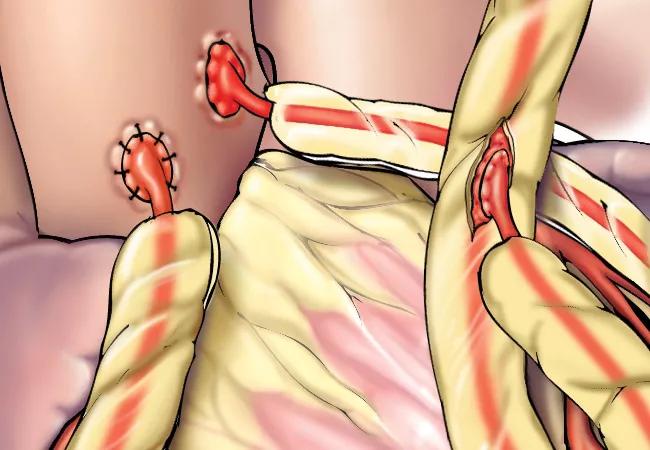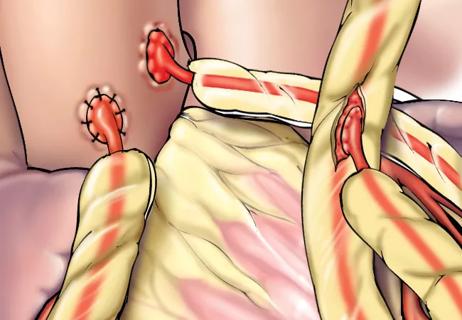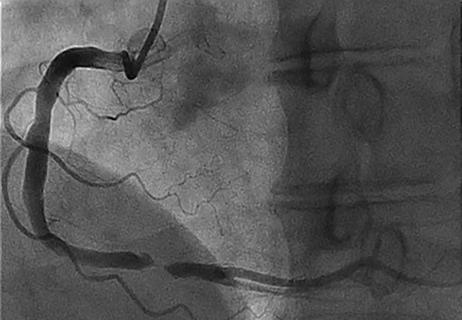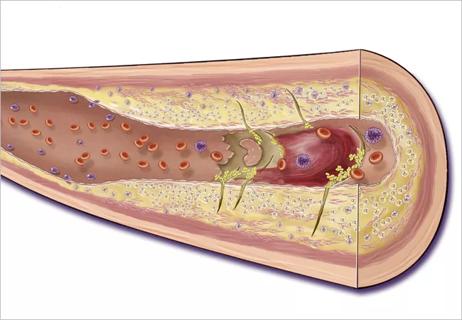Study indicates lower in-hospital mortality and better long-term survival

Multiarterial grafting in primary coronary artery bypass surgery — versus the use of a vein graft for one or more conduits — has long been championed by Cleveland Clinic cardiothoracic surgeons. A new study now shows its benefits for select patients having coronary artery bypass grafting (CABG) reoperations as well.
Advertisement
Cleveland Clinic is a non-profit academic medical center. Advertising on our site helps support our mission. We do not endorse non-Cleveland Clinic products or services. Policy
The study published in The Journal of Thoracic and Cardiovascular Surgery (2024 Oct 18:S0022-5223(24)00927-9) reported that redo CABG with multiarterial grafting produced lower in-hospital mortality yet similar morbidity when compared with less-complex single-arterial grafting. It also resulted in better long-term survival, specifically in males with bilateral internal thoracic artery (ITA) grafts.
“More surgeons have begun using multiarterial grafting in primary procedures since Cleveland Clinic’s landmark study 25 years ago, which showed better outcomes for patients who had two ITA grafts instead of one,” says Faisal Bakaeen, MD, the 2024 study’s senior author and Director of Cleveland Clinic’s Coronary Artery Bypass Surgery Center. “Our latest study bolsters those original findings, adding that multiarterial grafting also is superior to single-arterial grafting in redo procedures, a topic that has lacked research data until now.”
A commentary accompanying the study (2024 Nov 17:S0022-5223(24)01040-7) praises the new research as “one of the most significant publications on the subject to date” due to its “rigor, depth of analysis and case volume.”
Dr. Bakaeen and colleagues studied the medical records of more than 6,500 adults who had CABG reoperations at Cleveland Clinic from 1980 to 2020. These patients were propensity score-matched into 2,005 pairs, one patient with multiarterial grafting and one patient with single-arterial grafting (with or without additional vein grafting).
Advertisement
The median length of hospital stay after CABG reoperation was seven days for both multi- and single-arterial groups. The incidence of major morbidity after surgery also was similar: 13% in the multiarterial group and 11% in the single-arterial group (P = .28).
In-hospital postoperative complications were as follows:
| Multiarterial grafting | Single-arterial grafting | |
|---|---|---|
| Any reoperation | 50 (2.5%) | 65 (3.2%) |
| Renal failure | 73 (3.6%) | 55 (2.7%) |
| Stroke | 44 (2.2%) | 38 (1.9%) |
| Deep sternal infection | 36 (1.8%) | 25 (1.2%) |
| Any reoperation | ||
| Multiarterial grafting | ||
| 50 (2.5%) | ||
| Single-arterial grafting | ||
| 65 (3.2%) | ||
| Renal failure | ||
| Multiarterial grafting | ||
| 73 (3.6%) | ||
| Single-arterial grafting | ||
| 55 (2.7%) | ||
| Stroke | ||
| Multiarterial grafting | ||
| 44 (2.2%) | ||
| Single-arterial grafting | ||
| 38 (1.9%) | ||
| Deep sternal infection | ||
| Multiarterial grafting | ||
| 36 (1.8%) | ||
| Single-arterial grafting | ||
| 25 (1.2%) |
However, in-hospital mortality was lower for patients in the multiarterial group: 35 (1.7%) versus 56 (2.8%) (P = .03).
“This lower mortality rate is noteworthy, especially given the higher complexity of the multiarterial procedure,” says Dr. Bakaeen. “Equally noteworthy is the comparable rate of deep sternal infection between procedures. We suspect that fear of sternal infection has prevented more surgeons from performing bilateral ITA grafting, but that fear seems to be unfounded according to this study. At Cleveland Clinic, we regularly consider bilateral ITA for primary and redo procedures.”
Patients’ overall survival was better after multiarterial grafting (P < .0001) in both earlier and later stages of follow-up. Results were as follows:
| Survival | Multiarterial grafting | Single-arterial grafting |
|---|---|---|
| 1 year | 95% | 94% |
| 3 years | 92% | 88% |
| 5 years | 87% | 82% |
| 15 years | 49% | 42% |
| 20 years | 31% | 25% |
| Survival | ||
| 1 year | ||
| Multiarterial grafting | ||
| 95% | ||
| Single-arterial grafting | ||
| 94% | ||
| 3 years | ||
| Multiarterial grafting | ||
| 92% | ||
| Single-arterial grafting | ||
| 88% | ||
| 5 years | ||
| Multiarterial grafting | ||
| 87% | ||
| Single-arterial grafting | ||
| 82% | ||
| 15 years | ||
| Multiarterial grafting | ||
| 49% | ||
| Single-arterial grafting | ||
| 42% | ||
| 20 years | ||
| Multiarterial grafting | ||
| 31% | ||
| Single-arterial grafting | ||
| 25% |
“The survival benefit of multiarterial grafting lasted to at least 25 years,” Dr. Bakaeen says. “We hypothesize that it is due to greater patency of the grafts, causing fewer cardiovascular events.”
According to multivariable analysis, patients who had the best survival after multiarterial grafting for a redo CABG were males with two patent ITA grafts.
The researchers theorize that the limited benefit in women may be due to multiple factors, including:
Advertisement
However, more study is required on the differing outcomes between men and women, says Dr. Bakaeen, noting that women made up only 12% of patients in the redo CABG study. The survival difference has not been seen in primary CABG procedures.
Limitations of this study include its observational design and reliance on data from a single referral center with expertise in cardiac reoperations and multiarterial grafting. As such, the findings are not externally validated and may not be reproducible.
However, authors of the accompanying editorial praise the “valuable insight” offered in the study, noting that “the analysis comes from a uniquely high-volume, high-expertise center that averaged 12 cases of isolated redo CABG per month over a 40-year period. To our knowledge, few centers worldwide, if any, have comparable experience.”
Surgical experience is key to achieving favorable outcomes in CABG reoperation, especially when facing the challenge of redoing multiarterial grafting, says Dr. Bakaeen.
“Multiarterial grafting for both first time and redo operations is the way of the future,” adds Cleveland Clinic interventional cardiologist Laura Young, MD. “While it is still important to recognize that each surgery is individualized for the patient, if multiarterial grafting is technically feasible and clinically appropriate in terms of a patient’s risk factors, then it should be our first-line approach.”
Advertisement
Advertisement

BITA grafts themselves are rarely to blame, and outcomes can be good

Two cardiac surgeons explain Cleveland Clinic’s philosophy of maximizing arterial graft use

Cleveland Clinic-pioneered repair technique restores a 61-year-old to energetic activity

How Cleveland Clinic supported an alliance hospital to improve early extubation practices

Why and how we’re using robotic assistance for qualifying CABG candidates

Findings undercut perceptions of radial artery as second conduit of choice

The case for a thoughtful approach to CTO and minimally invasive options for CABG

Weakened endorsements in settings of normal EF and mild-moderate LV dysfunction may cause harm